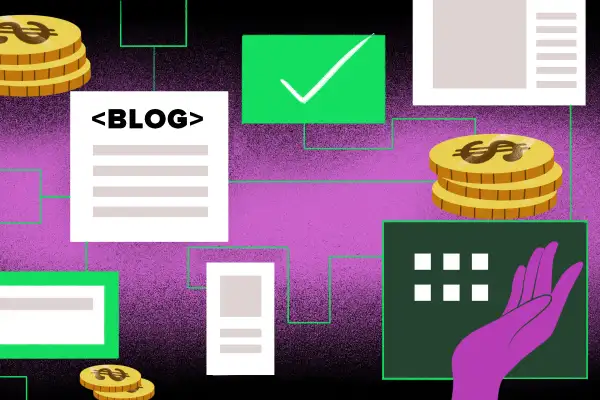How to Start a Blog and Make Money

Blogging doesn’t just have to be a hobby — there are ways you can strategize your blog idea to make side income, or even a full-time living. It’s important to have a plan in place if you want to make money blogging, so here’s how you can get started.
Table of Contents
- How to start a blog
- How to make money blogging
- How to start a blog and make money FAQ
- Summary of How to start a blog and make money
How to start a blog
Like any website or online platform, you’ll need to have a content strategy in place, creative ideas, and a set schedule to reap the best results and put yourself on a path to earning money blogging.
1. Pick a topic
It may sound cliche, but writing what you know is always sound advice. This is especially true when it comes to your own blog.
It's important to center it around issues that you're both passionate and knowledgeable about when you're starting your own site.
This will help you stay motivated to create new content frequently, which will be essential to your blog's popularity. You'll also be more likely to create engaging, truly helpful content that readers are more likely to share on social media.
Writing about topics you have established expertise on increases your credibility and authority, which can help you both grow an audience and improve your ranking in search engine results.
2. Purchase a domain name
Put simply, a domain name is the name of your website, or what comes after the “www” in a web address.
To purchase a domain name, look for a domain registrar — a company that sells and registers website domains — that’s accredited by the Internet Corporation for Assigned Names and Numbers (ICANN). ICANN is a nonprofit organization that coordinates IP addresses and namespaces on the internet. You can also do it directly with a web hosting company, many of which typically offer a free domain name for a year with a hosting plan subscription.
You can choose your new domain name before building your website or later on, if you decide to start with a free blog domain. However, it’s a good idea to buy it as soon as you have an official brand or blog name.
You’ll also have to decide on a domain extension or a top-level domain (TLD). Even though there are hundreds of domain extension options, .com and .net are the most popular and are usually given preference by search engines like Google.
Choosing one of these two could, in the long run, help your blog rank higher in the results page than if you choose less common extensions like .blog or .club, for instance.
3. Select a hosting service
To get your blog online, you’ll need a web hosting service.
A web host is a company that can store, maintain and manage access and traffic to your website. A web hosting service is necessary — it gives your website a home, and without it you wouldn’t be able to publish your site on the internet.
Most web hosting providers, including popular options such as Bluehost, Dreamhost, SiteGround and GoDaddy, offer three types of hosting services.
Shared hosting: Refers to a service where a single web server hosts many websites. It’s one of the most popular types of web hosting, and affordable since the server is shared with multiple users.
Virtual Private Server (VPS) hosting: A service where multiple websites are hosted on the same server, but each user gets dedicated resources. VPS hosting is more expensive than shared hosting and may require some technical knowledge to configure.
Dedicated hosting: Provides a dedicated server for your website. It’s ideal for websites with heavy traffic that can benefit from more responsiveness and the flexibility to upgrade and control performance. It’s expensive, though, with monthly plans ranging from $100 to over $200.
Make sure that when you’re selecting a web hosting service, it provides the type of service your blog needs within your budget. Also consider factors such as the server’s uptime, response time, scalability, ease of use and customer support.
Reports like the Signal’s WordPress Hosting Performance Benchmarks and HRANK’s Web Hosting Companies Rating provide reliable data on web hosting companies’ uptime metrics and may give you an overall idea of its performance. And check out our guide to the best web hosting companies for some great choices.
4. Choose a blogging platform
Blogging platforms allow you to create, manage and publish your content. Most of them also include tools for optimizing your website with metadata, title descriptions and keywords that make it easy for search engines to identify what the page is about.
Many platforms offer both free and paid options, including some of the most widely used sites like WordPress, Medium, Weebly and Blogger. There are also website builders like Wix and Squarespace, which require less tech-savviness.
Some platforms also come with pre-made themes that you can customize. A theme typically includes templates, layouts, colors, images and other features you need to format the website and its content.
But your theme affects much more than your page’s looks — your blog’s theme can also impact your ranking in search engine results. When choosing a template, do some research first and make sure it’s responsive, loads quickly, is mobile-friendly and works with plugins.
5. Publish your first blog post
Once you’ve picked a web hosting service, a blogging platform and a theme for your website, you’re ready to start your blogging journey.
There’s a lot of competition on the internet when it comes to content, so be sure to create original, high-quality posts on a regular basis.
Keep in mind what potential readers are looking for and why (otherwise known as the user search intent), your blog's central theme, and what others have already published on the topic. This way you can identify what needs to be written or how to present the information in an original and creative way.
Keyword research through Google Analytics (or even just Google Search) is key to finding relevant content ideas. Learning proper search engine optimization (SEO) techniques is also essential if you want to increase traffic to your site and rank higher in the results page.
Lastly, it's important to stay authentic to your voice and be mindful of your grammar. Mistakes and typos can be off-putting to many readers and take a toll on your site's credibility. If grammar isn't your strong suit, it's a good idea to invest in one of the many writing-assistance apps on the market.
How to make money blogging
Gaining and growing an audience may take a lot of time and effort, as does earning credibility and generating traffic. You’ll have to be patient on your way to profiting from your blog, which is largely dependent on traffic.
It's important to create content consistently and establish a social media presence — once you do so, there are quite a few ways to start making money from your blog.
1. Display ads
A simple way to start earning some revenue is to sell ad space.
Letting brands advertise on your page has many advantages, especially since it doesn't require a big time investment from you.
There are two ways to generate income selling ad real estate:
Cost per click (CPC): Also known as pay per click (PPC), this means you get paid each time users click on an ad shown on your website.
Cost per thousands (CPM): Also known as cost per mile, this lets you negotiate a set price for every 1,000 impressions (or views) the ad gets.
To get started, you’ll need to create an account with an advertising network, such as Google AdSense, Mediavine, BuySellAds, PropellerAds or other similar platforms.
Tip: Use ads judiciously. Filling up your site with tons of ads can affect its ranking, credibility, load time and, ultimately, the user’s experience.
2. Join affiliate programs
Many bloggers sample products or services and review them on their site using affiliate links (or tracking links) that redirect readers to the sellers’ website.
This process is known as affiliate marketing and it lets you earn a commission for every sale, click, lead or transaction your content generates to a seller or company.
There are several affiliate programs and networks you can join, including some from popular stores and e-commerce sites. These include:
Amazon Associates
Apple
WalMart
Commision Junction
ShareASale
eBay Partner Network
Joining an affiliate program will let you find a list of products to review and tools that let you keep track of links’ performance and increase conversion rate — that is, the number of users that complete a desired action or transaction in your site.
Tip: Set up news alerts to find hot new products your readers might be interested in.
3. Sell products
Selling your own products or services is another good monetization method for a blog.
Make time to create products that add value to your readers and visitors, preferably things that tie in with your blog. These can be physical products like books or prints, or digital products like PDFs or audio files that your readers can download.
Most web hosting providers and blogging platforms have widgets and other features that you can add to create an online store. These are typically known as plugins, which are a bit of code that give your website added functionality. Plugins give you the ability to add secure contact forms, optimize your images or create online stores.
There are also many popular WordPress plugins and eCommerce platforms like WooCommerce, BigCommerce, Ecwid and Shopify you can use to get started.
Tip: Don’t have your blog revolve around your products even if you add an online store. Instead, keep creating the high-quality content that attracted readers in the first place.
4. Post sponsored content
Many popular bloggers seek out sponsorships, which entails a company paying them to write sponsored posts that promote or talk about its products.
Let’s say you occasionally upload tutorial videos to your photography blog showing how you edit photos in a particular app or software. You could then approach the app manufacturer and ask whether they’d be interested in sponsoring that particular post.
To get a sponsorship, you usually have to reach out to a brand and make a pitch. Your pitch should include a brief explanation of who you are and what you do, along with details on your blog’s performance, such as audience demographics and traffic statistics.
Alternatively, you can try writing paid reviews. This option is like a sponsorship with one main difference: you’re sent a product for free or given early access to an app or software, so that you can test it and write a review about it.
Tip: Think of your readers when you seek out sponsorships. Make sure to review products or partner with companies that are relevant to your blog’s content and that your audience will find helpful.
5. Create a membership
Some readers may be willing to pay for a membership plan to get access to exclusive content, such as downloadable PDFs, in-depth articles, forums, podcasts, online courses or subscription boxes.
Subscriptions can be set up using membership-builder plugins. There are many popular options you can install easily, such as:
- WooCommerce Memberships
- LearnDash
- MemberPress
- Restrict Content Pro
Most membership plugins offer guides and tools to regulate content access, create membership levels and integrate payment options.
Tip: Look for a membership plugin that can handle a growing audience, and that offers flexible membership options and pricing.
6. Create a newsletter
With the right email marketing strategy and a large enough email list, you could also create a profitable newsletter.
Creating a profitable newsletter involves some of the same strategies that monetizing your blog entails. For example, you could reach out to a brand your readers would be interested in and offer advertising space in your newsletter.
You could also do affiliate marketing: mention or recommend a particular product within the newsletter and add its tracking or affiliate links. This way you can receive a commission for every transaction your subscribers complete.
Tip: Add a newsletter signup to your blog to get readers’ email and consider using email marketing software, such as Constant Contact and Mailchimp, to manage and automate your newsletter. Just make sure you’re not spamming your readers by sending out too much email marketing.
How to start a blog and make money FAQ
How to make a living blogging
How to start a successful blog
How much can you make blogging?
Summary of How to start a blog and make money
- You can make a full-time income from a successful blog, provided you have the right tools and strategies.
- Pick a topic that you’re both passionate and knowledgeable about. This will enhance credibility with audiences and positively impact your search engine ranking.
- Buy a domain name. Look for an ICANN-accredited domain registrar.
- Choose a web hosting provider. Consider the server’s uptime stats, response time, ease of use and customer support availability.
- Pick a blogging platform. The most popular services provide both free and paid options.
- Publish your blog. Keep in mind what potential readers are looking for and why, your blog’s purpose, and what competitor sites have already written about.
- Some popular methods to make money from a site include displaying ads, joining affiliate programs, creating newsletters and membership plans, creating and selling your own products and seeking out content sponsorships.


